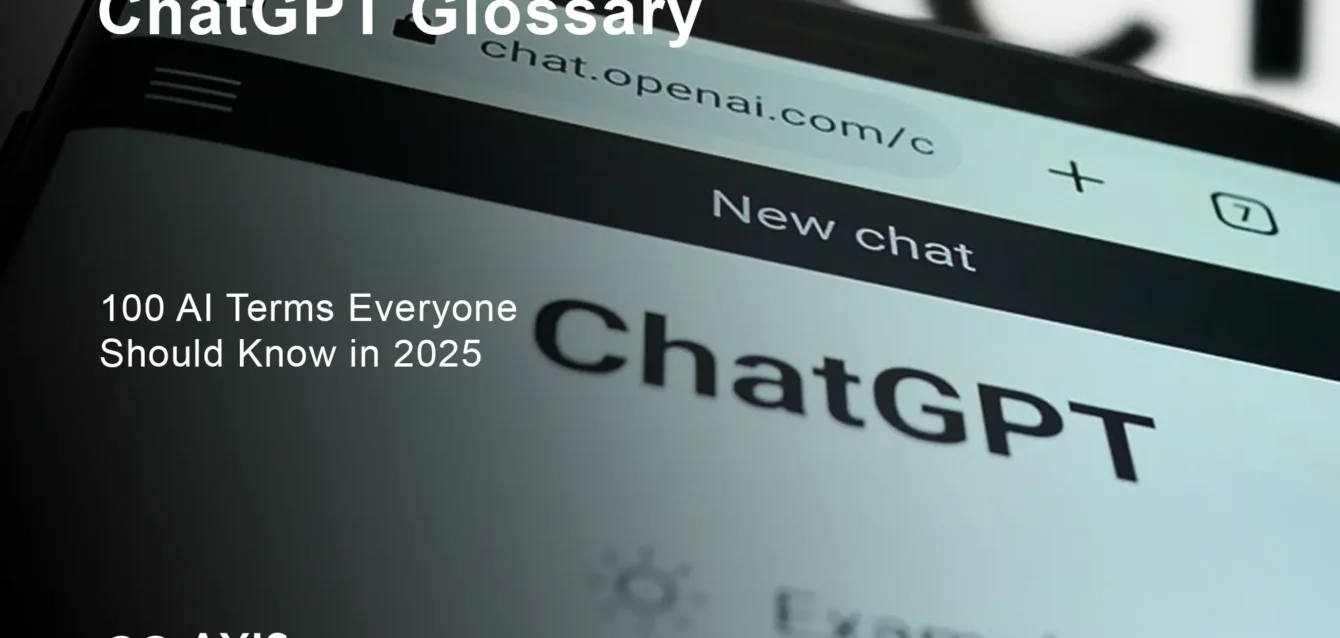ChatGPT Glossary 2025
If you’ve ever felt lost in an AI conversation, you’re not alone. With ChatGPT reaching 400 million weekly users by February 2025 and generative AI potentially adding $4.4 trillion annually to the global economy, understanding AI terminology has become essential for professionals across all industries.
Recent studies show that ChatGPT has already influenced how we speak, with words like “delve” and “meticulous” becoming more common in everyday conversation. As AI continues reshaping everything from software development (29% of all ChatGPT invites) to content creation, mastering AI vocabulary gives you a competitive edge in today’s technology-driven world.
This comprehensive glossary breaks down 100 crucial ChatGPT and AI terms into digestible explanations, complete with real-world examples and practical applications. Whether you’re implementing AI in your business, studying machine learning, or simply want to understand the technology transforming our world, this resource provides the foundation you need.
ChatGPT Terminology
Table des matières
- Core AI and Machine Learning Fundamentals
- ChatGPT and Language Model Specifics
- Natural Language Processing (NLP) Terms
- Deep Learning and Neural Networks
- Training and Model Development
- Technical Architecture and Implementation
- AI Safety, Ethics, and Governance
- Practical Applications and Use Cases
- Advanced AI Concepts and Methodologies
- Industry Terms and Business Applications
Core AI and Machine Learning Fundamentals
1. Artificial Intelligence (AI)
The simulation of human intelligence processes by machines, encompassing reasoning, learning, perception, and problem-solving. Modern AI systems like ChatGPT demonstrate capabilities in language understanding, creative writing, and complex analysis that were previously exclusive to human cognition.
Exemple concret: AI powers recommendation engines on Netflix, fraud detection in banking, and autonomous vehicle navigation systems.
2. Machine Learning (ML)
A subset of AI where systems automatically learn and improve from experience without being explicitly programmed for every task. ML algorithms identify patterns in data to make predictions or decisions on new, unseen information.
Key distinction: Unlike traditional programming where humans write specific instructions, ML systems develop their own approaches based on training data.
3. Artificial General Intelligence (AGI)
A theoretical form of AI that would match or exceed human cognitive abilities across all domains, including creativity, emotional intelligence, and abstract reasoning. Current AI systems, including ChatGPT, are considered “narrow AI” focused on specific tasks.
Current status: AGI remains a research goal, with experts debating whether it’s achievable and when it might emerge.
4. Deep Learning
An advanced machine learning technique using artificial neural networks with multiple layers to process data. Deep learning enables breakthrough capabilities in image recognition, natural language processing, and game-playing AI systems.
Technical detail: “Deep” refers to the many layers (sometimes hundreds) that process information hierarchically, from simple patterns to complex concepts.
5. Neural Network
A computational model inspired by biological neural networks, consisting of interconnected nodes (neurons) that process information. Each connection has weights that adjust during training to improve performance.
Analogy: Like a simplified version of brain neurons, these artificial networks learn by strengthening or weakening connections based on experience.

6. Algorithm
A set of mathematical instructions or rules that a computer follows to solve problems or complete tasks. In AI, algorithms determine how models process data and make decisions.
Examples: Gradient descent (for training), backpropagation (for learning), and attention mechanisms (for focus).
7. Large Language Model (LLM)
AI systems trained on vast amounts of text data to understand and generate human-like language. LLMs like GPT-4, Claude, and Gemini can perform various language tasks including writing, translation, and reasoning.
Échelle: Modern LLMs are trained on hundreds of billions of words from books, websites, and other text sources.
8. Generative AI
AI systems that create new content including text, images, code, music, or video based on learned patterns from training data. ChatGPT exemplifies generative AI for text creation.
Distinction: Unlike discriminative AI (which classifies existing data), generative AI produces entirely new content.
9. Natural Language Processing (NLP)
The field of AI focused on enabling computers to understand, interpret, and generate human language. NLP combines computational linguistics with machine learning to bridge the gap between human communication and computer understanding.
Applications: Machine translation, sentiment analysis, text summarization, and conversational AI systems.
10. Supervised Learning
A machine learning approach where models learn from labeled examples, with input-output pairs provided during training. The system learns to map inputs to correct outputs based on these examples.
Exemple: Training an email classifier by showing it thousands of emails labeled as “spam” or “legitimate.”
ChatGPT and Language Model Specifics
11. ChatGPT
OpenAI’s conversational AI system built on the GPT (Generative Pre-trained Transformer) architecture and fine-tuned for dialogue. ChatGPT combines the language generation capabilities of GPT models with conversational training to create helpful, harmless, and honest responses.
Evolution: From GPT-3.5 to GPT-4, each iteration has improved reasoning, reduced hallucinations, and expanded capabilities.
12. GPT (Generative Pre-trained Transformer)
A family of autoregressive language models that predict the next word in a sequence based on previous context. GPT models are pre-trained on diverse text data and can be fine-tuned for specific applications.
Architecture: Based on the transformer model introduced in “Attention is All You Need” (2017).
13. OpenAI
The AI research organization founded in 2015 that developed ChatGPT and the GPT model family. OpenAI’s mission focuses on ensuring artificial general intelligence benefits humanity.
Notable releases: GPT-1 (2018), GPT-2 (2019), GPT-3 (2020), ChatGPT (2022), GPT-4 (2023).
14. Prompt
The input text provided to language models to initiate a response. Effective prompting has become a crucial skill for maximizing AI system performance and achieving desired outputs.
Components: Can include instructions, examples, context, and specific formatting requirements.
15. Prompt Engineering
The practice of designing and optimizing prompts to elicit desired responses from AI models. This emerging discipline combines understanding of model behavior with strategic communication techniques.
Techniques: Few-shot examples, chain-of-thought reasoning, role-playing, and system instructions.
16. Token
The basic unit of text processing in language models, representing words, parts of words, or individual characters. Most models break text into subword tokens using algorithms like Byte Pair Encoding (BPE).
Exemple: “ChatGPT” might be tokenized as [“Chat”, “G”, “PT”] or [“Chat”, “GPT”] depending on the tokenizer.
17. Tokenization
The process of converting text into tokens that language models can process. Different tokenization strategies affect model performance and efficiency across languages and domains.
Impact: Better tokenization can improve model understanding and reduce computational costs.
18. Context Window
The maximum amount of text (measured in tokens) that a language model can consider when generating responses. This limits how much conversation history or document content the model can reference.
Evolution: GPT-3 had 4,096 tokens, while GPT-4 Turbo supports up to 128,000 tokens, enabling much longer conversations and document analysis.
19. Autoregressive Model
A type of model that generates sequences by predicting one element at a time, using previously generated elements as input for the next prediction. ChatGPT generates text word by word using this approach.
Process: Each new token is generated based on all previous tokens in the sequence.
20. Inference
The process of using a trained model to generate predictions or responses for new inputs. During inference, the model applies learned patterns without updating its parameters.
Distinction: Training teaches the model, while inference applies that knowledge to new situations.
Natural Language Processing (NLP) Terms
21. Natural Language Understanding (NLU)
A subset of NLP focused on comprehending human language input, including meaning, intent, and context. NLU enables systems to interpret what users really want, not just what they literally say.
Applications: Virtual assistants understanding voice commands, chatbots interpreting user requests.
22. Natural Language Generation (NLG)
The process of converting structured data or internal representations into human-readable text. NLG systems can create reports, descriptions, summaries, and creative content.
Exemple: Converting database information into written product descriptions or generating weather reports from meteorological data.
23. Semantic Similarity
A measure of how closely related two pieces of text are in meaning, regardless of exact word matches. Semantic similarity helps AI understand synonyms, paraphrases, and conceptual relationships.
Application: Search engines use semantic similarity to find relevant documents even when queries don’t exactly match content.
24. Word Embeddings
Dense vector representations of words that capture semantic relationships in high-dimensional space. Words with similar meanings have similar embeddings, enabling mathematical operations on language.
Famous example: “King” – “man” + “woman” ≈ “queen” in embedding space.
25. Attention Mechanism
A technique that allows models to focus on relevant parts of input when processing information. Attention mechanisms help models understand which words or phrases are most important for specific tasks.
Analogy: Like highlighting important text while reading, attention helps models prioritize relevant information.
26. Self-Attention
A specific type of attention where models examine relationships between different parts of the same input sequence. Self-attention enables understanding of how words relate to each other within a sentence or document.
Breakthrough: Self-attention was key to the transformer architecture’s success in language modeling.
27. Multi-Head Attention
An extension of attention mechanisms that allows models to focus on different types of relationships simultaneously. Each “head” can attend to different aspects like syntax, semantics, or discourse structure.
Bénéfice: Provides richer understanding by capturing multiple relationship types in parallel.
28. Transformer Architecture
A neural network design introduced in 2017 that revolutionized NLP through self-attention mechanisms. Transformers process entire sequences simultaneously rather than sequentially, enabling better parallelization and longer-range dependencies.
Impact: Nearly all modern language models, including ChatGPT, are based on transformer architecture.
29. BERT (Bidirectional Encoder Representations from Transformers)
A transformer-based model that reads text bidirectionally (left-to-right and right-to-left simultaneously). BERT excels at understanding context and has influenced many subsequent language models.
L'innovation: Unlike autoregressive models, BERT can see the full context when processing each word.
30. Named Entity Recognition (NER)
An NLP task that identifies and classifies named entities in text, such as people, organizations, locations, dates, and monetary amounts. NER helps structure unstructured text data.
Exemple: In “Apple Inc. was founded by Steve Jobs,” NER would identify “Apple Inc.” as an organization and “Steve Jobs” as a person.
Deep Learning and Neural Networks
31. Artificial Neural Network
A computing system inspired by biological neural networks, consisting of layers of interconnected nodes that process information. Each node applies mathematical functions to inputs and passes results to connected nodes.
Structure: Input layer, hidden layers, and output layer working together to transform data.
32. Hidden Layer
Intermediate layers in neural networks between input and output layers. Hidden layers learn increasingly complex representations of data, with early layers detecting simple patterns and deeper layers recognizing abstract concepts.
Fonction: Extract and transform features from input data through learned weights and biases.
33. Activation Function
Mathematical functions that determine whether neurons should be activated based on their inputs. Activation functions introduce non-linearity, enabling neural networks to learn complex patterns.
Common types: ReLU (Rectified Linear Unit), sigmoid, tanh, and softmax functions.
34. Backpropagation
An algorithm for training neural networks by calculating gradients of the loss function with respect to each parameter. Backpropagation propagates error information backward through the network to update weights.
Process: Measures output error, calculates how each parameter contributed, and adjusts parameters to reduce future errors.
35. Gradient Descent
An optimization algorithm that minimizes loss functions by iteratively moving in the direction of steepest descent. Gradient descent is fundamental to training most machine learning models.
Analogy: Like rolling a ball down a hill to find the lowest point, representing optimal model parameters.
36. Loss Function
A mathematical function that measures the difference between model predictions and actual target values. Loss functions guide training by quantifying how “wrong” the model’s outputs are.
Examples: Cross-entropy loss for classification, mean squared error for regression.
37. Learning Rate
A hyperparameter that controls how much model parameters change during each training update. Learning rate balances training speed with stability and convergence quality.
Compromis: High learning rates train faster but may overshoot optimal solutions; low rates are stable but slow.
38. Epoch
One complete pass through the entire training dataset during model training. Training typically involves many epochs, with the model gradually improving its performance with each pass.
Contrôle: Researchers track validation performance across epochs to detect overfitting and determine when to stop training.
39. Batch Size
The number of training examples processed together in a single forward/backward pass during training. Batch size affects training speed, memory usage, and gradient quality.
Trade-offs: Larger batches provide more stable gradients but require more memory and may generalize worse.
40. Convolutional Neural Network (CNN)
A specialized neural network architecture designed for processing grid-like data such as images. CNNs use convolutional layers to detect local patterns and have achieved breakthrough results in computer vision.
Application: While primarily used for images, CNNs have also been applied to text processing and time series analysis.
Training and Model Development
41. Training Data
The dataset used to teach machine learning models how to perform specific tasks. Training data quality and diversity significantly impact model performance and generalization capabilities.
Composition: For language models, training data typically includes books, articles, websites, and other text sources.
42. Validation Data
A separate dataset used to evaluate model performance during training and tune hyperparameters. Validation data helps prevent overfitting by providing unbiased performance estimates.
Purpose: Acts as a proxy for real-world performance without contaminating the training process.
43. Test Data
A held-out dataset used for final model evaluation after training is complete. Test data provides the most realistic estimate of how models will perform on new, unseen data.
Critical rule: Test data should never be used during training or hyperparameter tuning to ensure unbiased evaluation.
44. Overfitting
A phenomenon where models perform well on training data but poorly on new data due to memorizing specific examples rather than learning generalizable patterns.
Prevention: Techniques include regularization, dropout, early stopping, and data augmentation.
45. Underfitting
The opposite of overfitting, where models are too simple to capture important patterns in the data, resulting in poor performance on both training and test data.
Solutions: Increase model complexity, add features, or train for more epochs.

46. Generalization
A model’s ability to perform well on new, unseen data that differs from its training examples. Good generalization is crucial for real-world AI applications.
Mesures: The gap between training and validation performance indicates generalization quality.
47. Regularization
Techniques used to prevent overfitting by adding constraints or penalties that discourage model complexity. Regularization helps models generalize better to new data.
Methods: L1/L2 regularization, dropout, weight decay, and early stopping.
48. Fine-tuning
The process of adapting a pre-trained model for specific tasks by training on domain-specific data. Fine-tuning leverages general knowledge while specializing for particular applications.
Exemple: Taking a general language model and fine-tuning it for medical text analysis or legal document processing.
49. Transfer Learning
A machine learning technique where knowledge learned from one task is applied to related tasks. Transfer learning enables faster training and better performance with limited data.
Avantage: Leverages existing learned representations rather than starting from scratch.
50. Pre-training
The initial phase of training large models on massive, general datasets before task-specific fine-tuning. Pre-training helps models learn broad patterns and representations.
Échelle: Modern language models are pre-trained on hundreds of billions of tokens from diverse text sources.
Technical Architecture and Implementation
51. Parameter
Numerical values within neural networks that determine model behavior and are learned during training. Modern language models have billions or trillions of parameters.
Échelle: GPT-3 has 175 billion parameters, while some newer models exceed 1 trillion parameters.
52. Hyperparameter
Configuration settings that control the training process but aren’t learned from data. Hyperparameters include learning rate, batch size, network architecture, and training duration.
Optimization: Hyperparameter tuning is crucial for achieving optimal model performance.
53. API (Application Programming Interface)
A set of protocols and tools for building software applications, allowing different programs to communicate. OpenAI provides APIs for accessing ChatGPT and other models.
Usage: Developers integrate AI capabilities into applications through API calls.
54. Model Architecture
The structural design of neural networks, including layer types, connections, and data flow patterns. Architecture choices significantly impact model capabilities and efficiency.
Examples: Transformers for language, CNNs for vision, RNNs for sequences.
55. Embedding Layer
A neural network component that converts discrete tokens (words, characters) into dense vector representations. Embedding layers enable models to work with categorical data mathematically.
Fonction: Maps each token to a learned vector that captures semantic properties.
56. Decoder
In transformer models, the component responsible for generating output sequences one token at a time. Decoders use previous outputs and encoder information to produce new tokens.
Rôle: ChatGPT primarily uses decoder-only architecture for text generation.
57. Encoder
A neural network component that processes input sequences and creates internal representations. Encoders extract features and patterns from input data for further processing.
Application: Used in translation models, BERT, and encoder-decoder architectures.
58. Layer Normalization
A technique that normalizes inputs to neural network layers, stabilizing training and improving convergence. Layer normalization is crucial for training very deep networks.
Bénéfice: Reduces internal covariate shift and enables higher learning rates.
59. Residual Connection
Network connections that allow information to skip layers, helping train very deep networks by preventing vanishing gradients. Residual connections enable gradients to flow directly through the network.
L'innovation: Residual connections were key to enabling much deeper and more powerful neural networks.
60. Softmax Function
A mathematical function that converts a vector of numbers into probability distributions. Softmax is commonly used in the output layer for classification tasks.
Property: Output probabilities sum to 1, making them interpretable as confidence scores.
AI Safety, Ethics, and Governance
61. AI Alignment
The challenge of ensuring AI systems pursue goals that are beneficial to humans and aligned with human values. Alignment becomes increasingly important as AI systems become more capable.
Défi: Defining and encoding human values in AI systems remains an open research problem.
62. AI Safety
An interdisciplinary field focused on developing AI systems that are reliable, controllable, and beneficial. AI safety research addresses both current risks and potential future challenges.
Champ d'application: Includes technical safety, societal impacts, and long-term existential risks.
63. Hallucination
When AI models generate information that appears confident and fluent but is factually incorrect or fabricated. Hallucinations are a significant challenge for reliable AI deployment.
Exemple: ChatGPT might confidently state false historical dates or invent non-existent research papers.
64. Bias
Systematic unfairness in AI outputs that can reflect prejudices present in training data or model design. Bias can manifest in gender, racial, cultural, or other demographic disparities.
Types: Historical bias, representation bias, measurement bias, and evaluation bias.
65. Fairness
The principle that AI systems should treat all individuals and groups equitably. Fairness in AI involves both technical metrics and broader ethical considerations.
Challenges: Different definitions of fairness can conflict, requiring careful consideration of context and values.
66. Explainable AI (XAI)
AI systems designed to provide clear explanations for their decisions and outputs. Explainability is crucial for trust, debugging, and regulatory compliance.
Methods: Attention visualization, feature importance, model-agnostic explanations, and interpretable architectures.
67. Guardrails
Policies, restrictions, and safety mechanisms designed to prevent AI systems from generating harmful, inappropriate, or dangerous content. Guardrails help ensure responsible AI deployment.
Mise en œuvre: Content filters, behavioral constraints, and monitoring systems.
68. Constitutional AI
An approach to training AI systems using a set of principles or “constitution” to guide behavior. Constitutional AI aims to create more aligned and beneficial AI systems.
Process: Models learn to critique and revise their own outputs based on constitutional principles.
69. Red Teaming
A practice adapted from cybersecurity where teams deliberately attempt to find vulnerabilities, biases, or harmful behaviors in AI systems. Red teaming helps identify and address safety issues.
Objectif: Discover failure modes before deployment to improve system robustness.
70. RLHF (Reinforcement Learning from Human Feedback)
A training method where AI models learn from human preferences and feedback rather than just predicting text. RLHF was crucial for making ChatGPT helpful and harmless.
Process: Human evaluators rank model outputs, and the model learns to generate responses that humans prefer.
Practical Applications and Use Cases
71. Chatbot
AI programs designed to simulate conversation with human users through text or voice interfaces. Modern chatbots like ChatGPT can handle complex, contextual dialogues across many topics.
Evolution: From simple rule-based systems to sophisticated language model-powered assistants.
72. Virtual Assistant
AI systems that help users complete tasks through natural language interaction. Virtual assistants can answer questions, schedule appointments, control devices, and provide information.
Examples: Siri, Alexa, Google Assistant, and increasingly sophisticated text-based assistants.
73. Code Generation
AI’s ability to write programming code based on natural language descriptions or partial implementations. Code generation tools help developers write, debug, and optimize software.
Impact: GitHub Copilot and similar tools have transformed software development workflows.
74. Text Summarization
The process of automatically creating concise summaries of longer documents while preserving key information. Summarization helps manage information overload in various domains.
Types: Extractive (selecting key sentences) and abstractive (generating new summary text).
75. Machine Translation
Automatically translating text or speech from one language to another using AI. Modern neural machine translation achieves near-human quality for many language pairs.

Avancement: Transformer-based models have dramatically improved translation quality and fluency.
76. Sentiment Analysis
AI techniques for determining emotional tone, opinions, or attitudes expressed in text. Sentiment analysis helps businesses understand customer feedback and public opinion.
Applications: Social media monitoring, product reviews, customer service, and market research.
77. Question Answering (QA)
AI systems that can understand questions in natural language and provide accurate answers. QA systems range from simple factual lookup to complex reasoning over multiple documents.
Formats: Reading comprehension, open-domain QA, and conversational question answering.
78. Content Moderation
Using AI to automatically identify and filter inappropriate, harmful, or policy-violating content on platforms. Content moderation helps maintain safe online environments at scale.
Challenges: Balancing free expression with safety, handling context and nuance, and avoiding bias.
79. Retrieval-Augmented Generation (RAG)
A technique that combines language models with external knowledge databases to provide more accurate and up-to-date information. RAG helps address knowledge limitations and hallucinations.
Process: Retrieve relevant documents, then generate responses incorporating that information.
80. Multimodal AI
AI systems that can process and generate content across multiple formats like text, images, audio, and video. Multimodal models enable richer interactions and understanding.
Examples: GPT-4V (vision), DALL-E (text-to-image), and systems that combine speech, text, and visual understanding.
Advanced AI Concepts and Methodologies
81. Few-Shot Learning
AI’s ability to perform new tasks with only a few examples, leveraging prior knowledge and pattern recognition. Few-shot learning enables rapid adaptation to new domains.
Exemple: Showing ChatGPT 2-3 examples of a specific writing style and having it generate similar content.
82. Zero-Shot Learning
AI’s capability to perform tasks without any specific training examples, relying entirely on general knowledge and instruction following. Zero-shot learning demonstrates remarkable generalization.
Puissance: GPT models can translate languages, write code, or answer questions about topics never explicitly seen in training.
83. Chain-of-Thought (CoT)
A prompting technique where AI models are encouraged to show their reasoning process step-by-step. CoT improves performance on complex reasoning and mathematical problems.
Bénéfice: Makes AI reasoning more transparent and often more accurate.
84. Emergent Behavior
Capabilities that AI models develop which weren’t explicitly programmed or trained, arising from complex interactions within the system. Emergent behaviors can be surprising and powerful.
Examples: Advanced reasoning, creativity, and problem-solving abilities that emerge in large language models.
85. Scaling Laws
Mathematical relationships describing how AI model performance improves with increases in model size, training data, or computational resources. Scaling laws guide AI development strategies.
Aperçu: Performance often improves predictably with scale, motivating larger models and datasets.
86. Temperature (Sampling)
A parameter controlling randomness in AI text generation. Higher temperatures produce more creative but potentially less coherent outputs, while lower temperatures are more conservative and predictable.
Gamme: Typically 0.0 (deterministic) to 1.0+ (highly random).
87. Top-k Sampling
A text generation method where the model selects the next token from the k most likely candidates. Top-k sampling balances quality with diversity in generated text.
Tuning: Different k values produce different styles, from conservative (low k) to creative (high k).
88. Top-p (Nucleus) Sampling
An alternative sampling method that selects from the smallest set of tokens whose cumulative probability exceeds threshold p. Top-p adapts the candidate set size based on probability distribution.
Avantage: More dynamic than top-k, adapting to different confidence levels in predictions.
89. Beam Search
A search algorithm that explores multiple sequence possibilities simultaneously, maintaining the most promising candidates at each step. Beam search helps find high-quality outputs.
Compromis: More computational cost for potentially better quality compared to greedy search.
90. Perplexity
A metric measuring how well a language model predicts text, with lower perplexity indicating better performance. Perplexity quantifies model uncertainty and fluency.
Calculation: Based on the probability the model assigns to actual text sequences.
Industry Terms and Business Applications
91. MLOps (Machine Learning Operations)
The practice of deploying, monitoring, and maintaining machine learning models in production environments. MLOps combines machine learning with DevOps principles for reliable AI systems.
Components: Model versioning, automated testing, monitoring, and continuous deployment.
92. Model Deployment
The process of making trained AI models available for real-world use, including integration with applications, infrastructure setup, and performance optimization.
Considerations: Latency, scalability, cost, and reliability requirements.
93. A/B Testing
Experimental method comparing two versions of an AI system to determine which performs better. A/B testing helps optimize AI applications through empirical evaluation.
Application: Testing different prompt strategies, model versions, or user interface designs.
94. Edge AI
Running AI models directly on local devices rather than cloud servers, enabling faster responses, better privacy, and reduced bandwidth usage.
Avantages: Real-time processing, offline capability, and data privacy.
95. Federated Learning
A machine learning approach where models are trained across multiple devices without centralizing data. Federated learning preserves privacy while enabling collaborative AI development.
Use case: Training on sensitive data that cannot leave local environments.
96. Synthetic Data
Artificially generated data that mimics real data patterns, useful for training AI when real data is scarce, expensive, or sensitive.
Applications: Privacy-preserving training, data augmentation, and testing edge cases.
97. Data Augmentation
Techniques for artificially expanding training datasets by creating modified versions of existing data. Data augmentation improves model robustness and generalization.
Methods: For text: paraphrasing, back-translation, and synonym replacement.
98. Model Compression
Techniques for reducing AI model size while maintaining performance, including quantization, pruning, and knowledge distillation. Compression enables deployment on resource-constrained devices.
Trade-offs: Model size versus accuracy and deployment constraints.
99. Quantization
A model compression technique that reduces the precision of model parameters, typically from 32-bit to 8-bit or lower. Quantization significantly reduces memory usage and computational requirements.
Impact: Can reduce model size by 75% with minimal accuracy loss.
100. Knowledge Distillation
A training technique where a smaller “student” model learns to mimic a larger “teacher” model, creating more efficient systems while preserving much of the original performance.
Bénéfice: Combines the knowledge of large models with the efficiency of smaller ones.
Real-World Case Studies and Applications
Case Study 1: GitHub Copilot’s Transformation of Software Development
GitHub Copilot, powered by OpenAI’s Codex model, exemplifies how code generation, few-shot learninget context window optimization work together in practice. With software development representing 29% of all ChatGPT prompts, this application demonstrates the practical impact of understanding AI terminology.
Mise en œuvre technique: Copilot utilise transformer architecture with specialized fine-tuning on code repositories. The system employs prompt engineering principles where developers write comments describing desired functionality, and the model generates corresponding code using autoregressive prediction.
Mesures de performance: Studies show 55% faster completion times for repetitive tasks, demonstrating how inference optimization et attention mechanisms translate into real productivity gains. The system’s context window allows it to understand surrounding code and maintain consistency across large files.
Key Terms in Action: Tokenization of code differs from natural language, hallucination manifests as syntactically correct but logically flawed code, and bias appears in coding style preferences learned from training data.
Case Study 2: Enterprise Content Creation with RAG Systems
A Fortune 500 media company implemented a Retrieval-Augmented Generation (RAG) system combining ChatGPT with their internal knowledge base, showcasing how multimodal AI, embedding techniques, and guardrails create business value.
Architecture Details: The system uses semantic similarity search through company documents stored as word embeddings in vector databases. Natural Language Understanding (NLU) components parse user queries, while natural Language Generation (NLG) creates brand-consistent content.
Training and Safety: Constitutional AI principles guide content generation, bias detection prevents discriminatory output, and content moderation systems filter inappropriate responses. RLHF training specifically on company values ensures alignment with corporate messaging.
Impact sur les entreprises: 300% increase in content production, 40% reduction in fact-checking time through improved accuracy, and 60% faster onboarding for new content creators who learn company style through AI assistance.
Défis techniques: Hallucination mitigation through source verification, context window management for long documents, and fine-tuning for industry-specific terminology.
Case Study 3: Healthcare AI with Safety-Critical Applications
A telemedicine platform’s implementation of ChatGPT for patient triage demonstrates how AI safety, explainable AIet conformité réglementaire intersect with practical AI deployment.
Safety Framework: Multiple guardrails prevent medical advice generation, red teaming exercises identify failure modes, and bias auditing ensures equitable treatment recommendations across demographic groups.
Technical Stack: Multi-head attention focuses on relevant symptoms, few-shot learning adapts to new medical conditions, and uncertainty quantification measures confidence levels in recommendations.
Compliance Integration: L'IA explicable provides reasoning for triage decisions, audit trails track all AI interactions, and human-in-the-loop systems ensure medical professionals review critical cases.
Performance Results: 50% reduction in initial triage time, 35% improvement in symptom capture completeness, and 90% patient satisfaction with AI-assisted interactions while maintaining zero medical liability incidents.
Understanding AI Model Behavior and Performance
Advanced Technical Concepts
Gradient Descent Optimization: Modern language models use sophisticated optimization algorithms beyond basic gradient descent. Adam optimizer et learning rate scheduling help models converge more effectively during pre-training phases lasting months.
Attention Pattern Analysis: Researchers study self-attention visualizations to understand how models process language. Multi-head attention patterns reveal that different heads specialize in syntax, semantics, and discourse relationships.
Emergent Capabilities: As models scale beyond certain parameter thresholds, they develop emergent behaviors not explicitly trained. These include chain-of-thought reasoning, analogical thinkinget cross-domain transfer.

Model Architecture Evolution
Transformer Variants: While ChatGPT uses decoder-only architecture, other successful patterns include encoder-decoder (T5), encoder-only (BERT), and mixture of experts designs that activate different parameters for different inputs.
Efficiency Improvements: Model compression techniques like quantization et knowledge distillation enable deployment on edge devices. Sparse attention patterns reduce computational complexity for long sequences.
Multimodal Integration: Next-generation models combine text with vision (GPT-4V), audio (Whisper), and structured data, requiring new tokenization strategies and embedding approaches.
FAQ: AI Terms Glossary
What’s the difference between machine learning and deep learning?
Apprentissage automatique is the broader field where systems learn from data without explicit programming. Apprentissage profond is a specific subset using neural networks with multiple hidden layers. Traditional ML might use decision trees or linear regression, while deep learning uses backpropagation et gradient descent to train complex architectures comme transformers.
Practical distinction: Deep learning excels with large datasets and complex patterns (like language or images), while traditional ML often works better with smaller, structured datasets.
How do ChatGPT’s “hallucinations” occur?
Hallucinations arise from the autoregressive nature of language models. During inference, the model predicts the most likely next token based on training data patterns, not factual databases. When temperature settings are high or training data contains errors, the model may generate confident-sounding but incorrect information.
Mitigation strategies: RAG systems ground responses in verified sources, fine-tuning on high-quality data reduces errors, and prompt engineering can request source verification.
Why is “context window” important for practical use?
Le context window determines how much conversation history or document content ChatGPT can reference. Early models with 4,000 tokens could only “remember” about 3,000 words. Modern models with 128,000+ tokens can process entire research papers or maintain context across long conversations.
Business impact: Larger context windows enable document analysis, detailed customer service histories, and complex multi-step reasoning tasks.
What makes “transformer architecture” revolutionary?
Transformers replaced sequential processing (RNNs) with parallel attention mechanisms. Instead of processing text word-by-word, self-attention examines all words simultaneously, identifying relationships regardless of distance in the text.
Technical advantage: Parallelization enables training on massive datasets, while attention patterns capture long-range dependencies that sequential models miss.
How does “RLHF” make ChatGPT helpful and safe?
Reinforcement Learning from Human Feedback involves three stages: supervised fine-tuning on human demonstrations, training a reward model to predict human preferences, and policy optimization where the model learns to maximize predicted human approval.
Safety benefit: RLHF aligns model behavior with human values, reducing harmful outputs and improving response quality beyond simple next-token prediction.
What’s the relationship between “tokens” and pricing?
Most AI APIs charge based on token usage because tokenization determines computational cost. Inference complexity scales with token count, not character count. Common words might be single tokens, while rare words or non-English text may require multiple tokens.
Optimisation des coûts: Understanding tokenization helps optimize invites for efficiency, using concise language and familiar vocabulary to minimize token usage.
How do “embeddings” enable AI to understand meaning?
Word embeddings convert text into high-dimensional vector spaces where semantic relationships become mathematical operations. Similar concepts cluster together, enabling models to understand synonyms, analogies, and conceptual relationships.
Mathematical property: “King” – “man” + “woman” ≈ “queen” because embeddings capture gender relationships learned from training data patterns.
What determines whether an AI model will “overfit” or “underfit”?
Overfitting occurs when models memorize training data specifics rather than learning generalizable patterns. Underfitting happens when models are too simple to capture important relationships.
Prevention: Regularization techniques, proper validation data usage, early stopping, and appropriate model complexity relative to data size help achieve optimal generalization.
Why are “parameters” crucial for AI capabilities?
Paramètres are learned weights that determine model behavior. More parameters generally enable more sophisticated pattern recognition and reasoning, but also require more training data and computational resources.
Scale relationship: Scaling laws show predictable performance improvements with parameter increases, driving the trend toward larger models like GPT-4’s hundreds of billions of parameters.
How does “prompt engineering” improve AI outputs?
Efficace prompting leverages models’ training patterns et few-shot learning capabilities. Chain-of-thought prompting encourages step-by-step reasoning, role-playing provides context, and examples demonstrate desired output formats.
Strategic elements: Clear instructions, relevant context, output format specification, and temperature adjustment for creativity versus consistency balance.
Latest AI Developments and Future Trends
2025 AI Landscape Shifts
Model Efficiency Focus: With inference costs becoming significant for deployment, research emphasizes model compression, quantizationet efficient architectures that maintain performance while reducing computational requirements.
Multimodal Integration: Beyond text-only models, multimodal AI systems combining vision, audio, and text are becoming standard, requiring new tokenization strategies and attention mechanisms.
Safety and Alignment: Constitutional AI, red teaminget RLHF improvements focus on creating more aligned, trustworthy AI systems as capabilities increase.
Emerging Technical Concepts
Mixture of Experts (MoE): Architecture where different model components specialize in different tasks, improving efficiency by activating only relevant parameters for each input.
Retrieval-Augmented Generation Evolution: RAG systems becoming more sophisticated with better semantic similarity matching and real-time knowledge integration.
Agentic AI Systems: Moving beyond single-response models toward AI that can plan, use tools, and execute multi-step tasks autonomously.
Industry Adoption Patterns
Intégration de l'entreprise: MLOps practices maturing, with better model deployment, monitoring, and Tests A/B frameworks for production AI systems.
Edge Computing: Edge AI deployment growing as model compression enables powerful AI capabilities on smartphones, IoT devices, and local servers.
Specialized Fine-tuning: Industry-specific fine-tuning becoming more common, with models adapted for legal, medical, financial, and technical domains.
Technical Implementation Guidelines
Best Practices for AI Integration
Data Preparation: Quality training data remains crucial. Data augmentation, synthetic data generation, and careful bias auditing improve model performance and fairness.
Sélection du modèle: Choose between few-shot learning with large models versus fine-tuning smaller models based on use case, data availability, and computational constraints.
Safety Implementation: Implement guardrails, content moderationet explainable AI features from the beginning rather than retrofitting safety measures.
Stratégies d'optimisation des performances
Context Management: Optimize context window usage through relevant information selection and prompt engineering to maximize model effectiveness within token limits.
Inference Optimization: Use quantization, model compression, and efficient decoding strategies to reduce latency and costs in production environments.
Monitoring and Evaluation: Implement comprehensive evaluation metrics beyond simple accuracy, including bias detection, hallucination monitoring, and user satisfaction tracking.
Future-Proofing AI Systems
Modular Architecture: Design systems that can easily integrate new models as Capacités en matière d'IA evolve, avoiding vendor lock-in and enabling model upgrades.
Ethical Framework: Establish clear AI ethics guidelines and alignment principles that can guide decisions as AI capabilities expand.
Apprentissage continu: Implement systems for ongoing fine-tuning and adaptation as user needs and data patterns evolve.
Mastering AI Vocabulary for Success
Understanding these 100 ChatGPT and AI terms provides the foundation for navigating our increasingly AI-driven world. From basic concepts like intelligence artificielle et apprentissage automatique to advanced topics like constitutional AI et emergent behaviors, this vocabulary enables more effective communication with AI systems and informed participation in AI-related discussions.
Key Takeaways for Practitioners:
- Technical Understanding: Grasping concepts like attention mechanisms, transformerset fine-tuning helps optimize AI tool usage and troubleshoot issues.
- Safety Awareness: Knowledge of hallucinations, biaset alignment challenges enables responsible AI deployment and risk mitigation.
- Applications commerciales: Understanding MLOps, RAGet model deployment concepts facilitates successful enterprise AI integration.
- Future Preparation: Familiarity with multimodal AI, agentic systemset scaling laws helps anticipate and adapt to rapid AI evolution.
The AI Revolution Continues: As ChatGPT reaches 400 million weekly users and IA générative transforms industries worldwide, this vocabulary serves as your guide through the technological transformation reshaping how we work, create, and communicate.
Next Steps: Bookmark this glossary as your reference guide, experiment with AI tools using these concepts, and stay updated on emerging terms as the field rapidly evolves. The future belongs to those who can speak the language of artificial intelligence fluently and apply these concepts effectively in their personal and professional endeavors.
Whether you’re implementing AI solutions in your business, studying apprentissage automatique, or simply staying informed about technology trends, mastering this AI vocabulary positions you for success in the age of artificial intelligence.
Sources and Further Reading:
- OpenAI Research Publications on GPT Architecture and Training
- McKinsey Global Institute Reports on AI Economic Impact
- Scientific American Studies on AI’s Influence on Human Language
- Academic Papers on Transformer Architecture and Attention Mechanisms
- Industry Reports on AI Adoption and Implementation Trends





